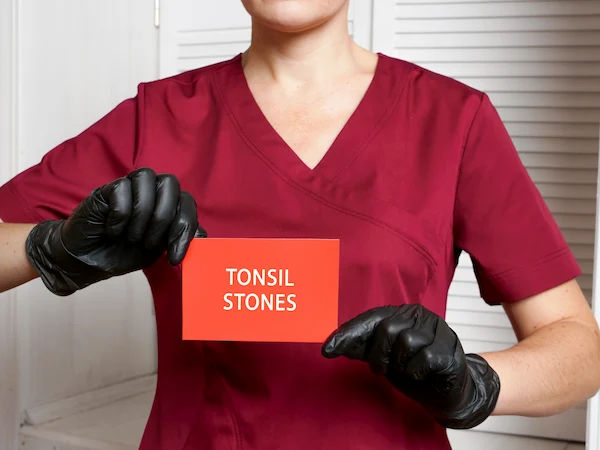Coblation Tonsillectomy: A Modern Path to Rid Yourself of Tonsillitis
Discover how coblation tonsillectomy offers a gentler, less painful, and faster recovery alternative to traditional tonsil removal methods. Learn the benefits, procedure, and recovery process.


Introduction
Are you or your child trapped in a relentless cycle of sore throats, missed school or work, and sleepless nights? If enlarged or infected tonsils are diminishing your quality of life, you've likely heard about tonsillectomy—the surgery to remove them. But the thought of a painful recovery might be holding you back. What if there was a more advanced, gentler way to rid yourself of the problem? Enter Coblation technology. This innovative procedure is revolutionising how ENTs perform tonsillectomies, offering significant benefits over traditional methods. This comprehensive guide will walk you through everything you need to know about getting rid of your tonsils through the coblation technique, from how it works to what you can expect during a smoother, faster recovery.
What Are Tonsils and What is Tonsillitis?
Tonsils are the two oval-shaped pads of tissue at the back of your throat. They are part of your immune system, acting as the first line of defence against germs. However, sometimes they become more of a liability than an asset.
Tonsillitis occurs when the tonsils become infected, leading to symptoms like severe sore throat, difficulty swallowing, fever, and swollen glands. While occasional tonsillitis is common, especially in children, some people experience chronic or recurrent infections. For adults, chronic tonsillitis can be a particularly debilitating condition, causing persistent discomfort and fatigue.
When is a Tonsillectomy the Right Choice?
An ENT specialist may recommend a tonsillectomy if you experience:
Recurrent infections: Seven or more episodes in one year, or five per year for two consecutive years.
Chronic tonsillitis: Infections that don't clear up completely with antibiotic treatment.
Sleep-disordered breathing: Enlarged tonsils that obstruct airflow, causing snoring or sleep apnoea.
Difficulty swallowing due to oversized tonsils.
An abscess that doesn't improve with drainage or antibiotics.
The decision is highly individual. If your condition does not improve after repeated rounds of antibiotics, consulting an ENT specialist online with Apollo24|7 can be a good first step to discuss your symptoms and explore if a tonsillectomy is appropriate for you.
Understanding Coblation: The Gentle Approach to Tonsil Removal
Coblation, short for "Controlled Ablation," is a state-of-the-art surgical technology that uses low-temperature radiofrequency energy to gently remove tissue. It's a significant departure from the "burn and cut" methods of the past.
How Does Coblation Technology Work?
Instead of generating intense heat, the coblation wand creates a precise plasma field. This field is energised by a saline solution, which breaks the molecular bonds in the tonsil tissue, effectively dissolving it away at a relatively cool temperature (typically 40-70°C). Think of it as vaporising the tissue layer by layer with minimal thermal damage to the surrounding areas. This precision is the key to its benefits, making it a preferred tonsillectomy procedure for adults and children alike.
Health topic carousel:
Doctor's speciality: ENT
Text: Consult a ENT specialist for the best advice
Coblation vs. Traditional Tonsillectomy: A Head-to-Head Comparison
Pain Levels and Patient Comfort
This is the most significant advantage. Because coblation operates at a much lower temperature, it causes far less thermal damage and charring to the sensitive throat muscles underneath the tonsils. Multiple studies have shown that patients who undergo coblation tonsillectomy report less post-operative pain and require fewer painkillers compared to those who have traditional surgery. This leads to better hydration and nutrition during recovery.
Risk of Bleeding During and After Surgery
The plasma field simultaneously dissolves tissue and seals blood vessels as it works. This controlled action results in minimal blood loss during the procedure. Furthermore, because the surrounding tissue is healthier and less charred, the risk of secondary bleeding—which often occurs when the scab falls off 7-10 days after surgery—is also reduced.
Recovery Time and Returning to Normal Life
Less pain and tissue trauma directly translate to a faster recovery time. While a traditional tonsillectomy can require 10-14 days or more off work or school, many coblation patients feel well enough to return to light activities within 5-7 days. The ability to eat and drink comfortably sooner is a major factor in this accelerated healing process.
The Coblation Tonsillectomy Journey: From Consultation to Recovery
Step 1: The Pre-Operative Consultation and Evaluation
Your ENT surgeon will review your medical history, perform a physical examination, and may order some tests, such as a throat culture or blood work, to ensure you are a good candidate for surgery. Apollo24|7 offers convenient home collection for pre-operative tests like a complete blood count (CBC), making preparation easier.
Step 2: What Happens on the Day of Surgery?
The procedure is performed under general anaesthesia, so you will be asleep and feel no pain. The surgeon will insert a small mouth guard and use the coblation wand to precisely remove the tonsils layer by layer. The entire surgery typically takes between 30 to 60 minutes.
Step 3: The Critical First 24-72 Hours of Recovery
You will wake up in a recovery room. Your throat will be sore, but many describe it as a severe sore throat rather than the sharp, razor-like pain associated with older methods. The key priorities are:
Pain Management: Take prescribed pain medication on schedule.
Hydration: Sip cool water, ice chips, or electrolyte drinks constantly. Dehydration is the most common cause of readmission.
Nutrition: Stick to a strict diet of soft, cold, and bland foods like ice cream, yoghurt, pudding, and mashed potatoes.
Step 4: The First Week and Beyond: Healing Timeline
Days 3-5: Pain may peak as the healing tissue forms a white or greyish scab (fibrin clot). This is normal and a sign of healing.
Days 5-10: The scabs will begin to slough off in small pieces. You might notice a slight increase in soreness or a tiny amount of blood-tinged saliva—this is usually normal. The coblation technique results in thinner, softer scabs that come off more easily, reducing the "pain peak."
Day 10+: Most people feel significantly better and can gradually return to a normal diet and activities.
Life After Tonsillectomy: What to Expect Long-Term
Potential Risks and How to Mitigate Them
No surgery is without risk. While reduced, bleeding and infection are still possible. Follow your doctor's instructions meticulously, especially regarding rest, hydration, and avoiding strenuous activity to minimise these risks.
The Benefits: Is It Worth It?
For the vast majority of patients, the answer is a resounding yes. The primary benefit is a dramatic reduction in throat infections. Patients with sleep apnoea often experience immediate improvement in their sleep quality and daytime energy levels. The short-term discomfort of recovery is a small price to pay for long-term health and wellness.
Conclusion
Living with chronic tonsil issues can be exhausting. The coblation tonsillectomy represents a major advancement in ENT surgery, offering a safer, less painful, and more efficient way to rid yourself of problematic tonsils. By choosing this modern technique, you are investing in a significantly smoother recovery and a quicker return to a healthy, active life. If you are suffering from recurrent tonsillitis or related issues, take the next step. Book a physical visit to an ENT specialist with Apollo24|7 to discuss whether you are a candidate for this transformative procedure. Don't let the fear of a painful recovery prevent you from seeking a permanent solution.
Frequently Asked Questions (FAQs)
1. Is coblation tonsillectomy suitable for adults?
Absolutely. In fact, adults often have a more painful recovery with traditional methods, so the benefits of coblation—namely reduced pain and faster healing—can be even more significant for them.
2. How much does a coblation tonsillectomy cost?
The cost of coblation tonsil removal can vary based on the hospital, surgeon's fee, and geographic location. It may be slightly more expensive than traditional surgery due to the advanced technology used, but many patients find the investment worthwhile for the improved recovery experience. It's best to check with your insurance provider and hospital for a precise estimate.
3. Are the results of a coblation tonsillectomy permanent?
Yes. The tonsils are completely removed, so they cannot grow back or become infected again. However, in very rare cases, small amounts of tissue can be left behind and may regrow, but this is not common.
4. What is the success rate of coblation tonsillectomy?
The success rate in terms of completely removing the tonsils is nearly 100%. The procedure is highly effective at eliminating the problems caused by diseased tonsils, with success rates for resolving chronic infections and sleep apnoea exceeding 90-95%.
5. How long does the coblation procedure itself take?
The actual surgical time for the coblation technique is typically between 30 and 60 minutes, though you will spend additional time in the operating room for anaesthesia preparation and in recovery afterwards.
Health topic carousel:
Doctor's speciality: ENT
Text: Consult a ENT specialist for the best advice
Consult Top Specialists for Personalised Tips

Dr. Sourav Banerjee
Ent Specialist
5 Years • MBBS, MS (Otorihnolaryngology)
New Delhi
THE DOCTORS NESST, New Delhi

Dr. Krishan Rajbhar
Ent Specialist
8 Years • MBBS, MS(ENT), Fellowship in Neurotology Fellowship in Middle Ear Surgery & Cochlear Implant, Fellowship in Allergy & Asthma
Kolkata
Dr. Krishan Rajbhar's Clinic, Kolkata
(150+ Patients)

Dr. M Venkata Apparao
Ent Specialist
25 Years • MBBS MS
Visakhapatnam
Apparao ENT CLINIC, Visakhapatnam

Dr. Nirupama Reddy
Ent Specialist
5 Years • MBBS, MS (Oto Rhino Laryngology)
Hyderabad
Nirupama clinic, Hyderabad
Dr. Suresh Tarikere Laxman
Ent Specialist
26 Years • M.B.B.S , M.S, DIPLOMA IN THYROID & DIABETES
Bengaluru
Surya Ent Clinic, Bengaluru
Consult Top Specialists

Dr. Sourav Banerjee
Ent Specialist
5 Years • MBBS, MS (Otorihnolaryngology)
New Delhi
THE DOCTORS NESST, New Delhi

Dr. Krishan Rajbhar
Ent Specialist
8 Years • MBBS, MS(ENT), Fellowship in Neurotology Fellowship in Middle Ear Surgery & Cochlear Implant, Fellowship in Allergy & Asthma
Kolkata
Dr. Krishan Rajbhar's Clinic, Kolkata
(150+ Patients)

Dr. M Venkata Apparao
Ent Specialist
25 Years • MBBS MS
Visakhapatnam
Apparao ENT CLINIC, Visakhapatnam

Dr. Nirupama Reddy
Ent Specialist
5 Years • MBBS, MS (Oto Rhino Laryngology)
Hyderabad
Nirupama clinic, Hyderabad
Dr. Suresh Tarikere Laxman
Ent Specialist
26 Years • M.B.B.S , M.S, DIPLOMA IN THYROID & DIABETES
Bengaluru
Surya Ent Clinic, Bengaluru




